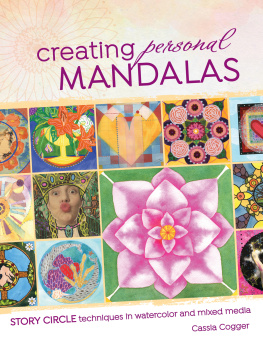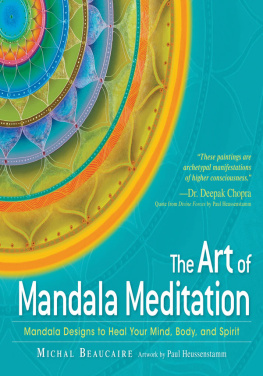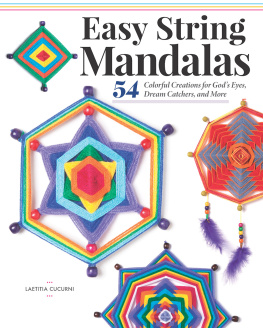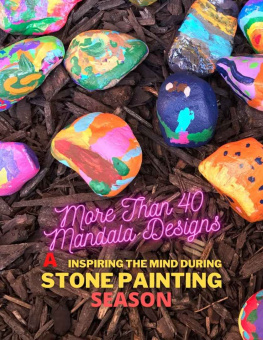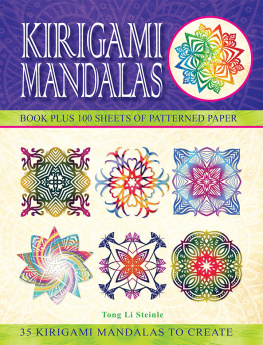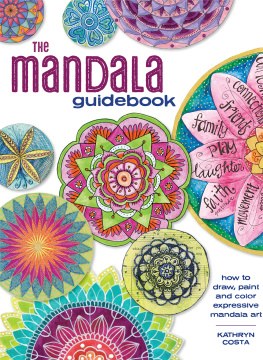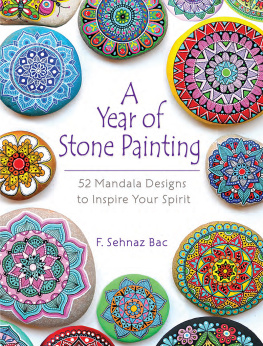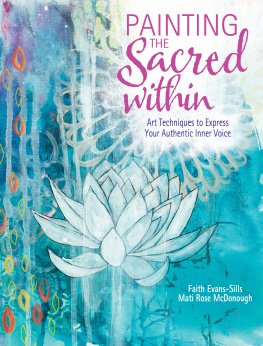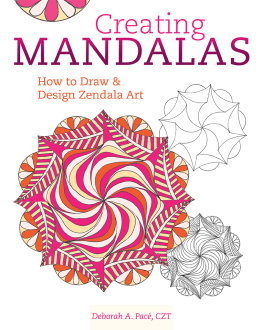Contents
Guide
creating personal
MANDALAS
STORY CIRCLE techniques in watercolor and mixed media
Cassia Cogger

CONTENTS
INTRODUCTION
Reconnect to Your Authentic Voice
CHAPTER 1
The Circle
CHAPTER 2
The Circle as a Mandala
CHAPTER 3
The Circle as a Story Slice
CHAPTER 4
Circles for Self-Discovery
CHAPTER 5
The Circle as a Boundary
CHAPTER 6
Finding Center
CHAPTER 7
The Circle as True North
CHAPTER 8
The Circle as Catharsis
CHAPTER 9
The Circle as a Tool for Intentional Design
CHAPTER 10
The Circle as a Tool for Manifestation
Dedication
For Steve, Millie and Calvin, who bring
depth and beauty to the mandala of my life.
INTRO
Reconnect to Your Authentic Voice
Reconnect to your voice, explore creative expression, relax your spirit. The time is now!
Does it sometimes seem like life swirls around you, leaving you feeling increasingly lost and slightly disconnected? As if youre not fully or even partially expressed? What if you could be? You can!
Lets reconnect to our authenticity and soothe our souls as we engage in painterly play within the sacred circle.
Regardless of your artistic experience, the pages that follow will guide you to create beautiful work centered around or created within the circle. More important, they will guide you to find the beautiful and sacred within yourself.
The story-circle process returns us again and again to the creative, expressive soul inside we so often forget about. Through a stunning blend of geometry, art-making and visual storytelling, the circles lead us back to center.
With open hearts and inquisitive minds, let us begin!
Mind-Set and Materials
Mind-Set
As with everything, the right mind-set is the most important thing you need for this book: a willingness to dive in and explore, to try new things; a commitment to staying with the processes while also staying tuned in to your own inner muse.
You will explore various techniques and create a number of projects on the following pages. Essential elements of design will be reviewed. When its all said and done you will create deeply meaningful works of art.
This process is about so much more than just making a pretty picture.
It is about connecting with a deeper part of yourself and working toward fuller self-expression.
It is about experience and journey, not outcome.
It is about reconnecting to your voice, exploring your own unique forms of creative expression and relaxing your spirit.
Please follow the tutorials, consider my prompts and experiment with my exercises, but at the end of the day follow your own creative inclinations. There is no wrong way.
Materials
In addition to a proper mind-set, all you really need to create a story circle is something to make a mark with and something to make a mark on.
In this book I will present exercises with specific materials. You may have something else available you would like to experiment with. Please do! First and foremost, were here to engage in creative expression and connect with self. Never let materials be a barrier to this process and remember, there is no wrong way!
I love the precision of creating a circle with a compass and dividing it with a sharp straightedge as I build the sacred vessel for my visual story. I can just as often be found drafting the same sacred shapes with dinner plates and cereal boxes or anything else available to me. Try both ways and find out which process appeals to you.
You can use fancy art paper, the kids construction paper, backs of old documents or plain copy paper. A pencil or a ballpoint pen makes a beautiful mark. Markers and watercolor paints, crayons from my kiddos coloring box or highlighters from the junk drawer are great sources for color.
That being said, in order to follow along with the playful and painterly exercises, you will need some specific materials. Each exercise has a specific list, though the following are things you will need in general.
General Materials
acrylic matte medium
compass
markers
paintbrushes: 1" (25mm) hake, foam brush, round watercolor brushes ranging in size from 0610
pens, pencils, paint pens
scissors
straightedge
substrates: watercolor paper, wood panel, canvas
water-based paints (acrylics, inks, watercolors)
water-soluble crayons

WATER-BASED PAINTS
I will be using a combination of watercolors, acrylics and inks.
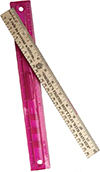
STRAIGHTEDGE
Any straightedge will work. I have incredibly fine rulers from my brief stint in architecture school but more often than not, I can be found using a wooden ruler I have had since elementary school or the edge of the closest book or box.
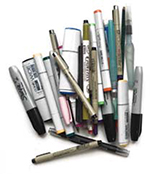
MARKERS AND PENS
I have a large collection of markers and pens. Make certain that you have 23 black pens or markers of varying sizes as well as a white paint or gel pen.
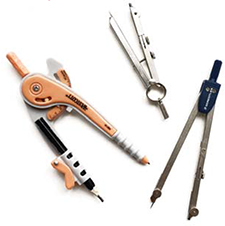
COMPASS
There is something magical about plugging into a point and creating the geometry of the circle as you guide the compass around the center. Choose one that opens up to allow for a 6" (15cm) radius. If precision is important to you, look for one that will lock. I have many and they all work, but my favorite is made by Staedtler, pictured here on the right.

SUBSTRATES
When creating a circle, I enjoy working on a square base. I prefer cold-pressed watercolor paper140-lb (300gsm), unfinished balsa panels and gallery-wrapped canvases. Each of these surfaces allows for a lot of layering, and the panels and gallery-wrapped canvases are nice for ease of hanging immediately upon completion.
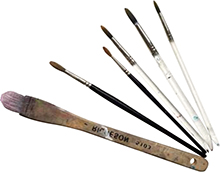
PAINTBRUSHES
Its a good idea to have a 1" (25mm) hake brush and watercolor brushes ranging in size from 0610 (Royal & Langnickel Aqualon brushes are nice options).
Watercolor Tips
Personal mandala creation does not require any specific materials or specialized techniques. Pencil or pen, paint or collage, really any artistic medium can be used to create a mandala. Markers are a very popular choice for bringing color to mandalas. Watercolor happens to be a favorite of mine, so I wanted to include a few tips for using it, should you decide to give it a try with your own mandalas.

